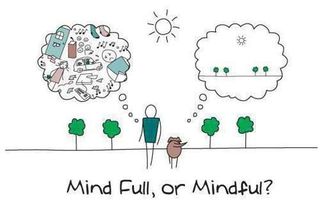Mindfulness
Mindfulness Parenting
How to take back the power and stop letting your child press your buttons.
Posted January 19, 2020 Reviewed by Devon Frye

There’s increasing evidence that mindfulness is a good thing. Mindfulness practices have been shown to reduce anxiety and depression, increase coping and various kinds of wellness, and assist children in dealing with learning, emotional, and behavioral problems. Mindfulness is also a potent tool for parents, especially when they’re feeling challenged by a child’s attitudes or behavior, and it’s easier to achieve than most people realize.
Mindfulness is the process of purposely bringing one's attention to what’s happening in the present moment, without judgment. It means consciously attending to being here, in this moment, right now. It is sometimes associated with religious practices like Zen Buddhism, but there is no religious aspect to the basic practice of attending to being here and now.
There are many ways to become mindful and reap the physical and psychological benefits of mindfulness. In addition to yoga, gratitude, conscious attention to one’s breathing, and time in nature, there is mindfulness meditation. There are as many ways to practice mindfulness meditation as there are courses being offered, but a basic starting session might go something like this, which I've modeled on suggestions from Laura Markham:
- Settle in. If possible, find a quiet space at a time you probably won’t be disturbed. You can be sitting on the floor or in a chair, or lying down, as long as your body is in a comfortable position.
- Breathe. Close your eyes. Take a deep breath. Notice your body relaxing. Feel the rise and fall of your chest. Attend to the expansion and contraction of your belly. Take another breath. Notice how the breath feels as it fills your lungs. Don’t try to control your breath, just feel it.
- Take another breath, and come back to being here, now. Take another breath, and, slowly, another. Thoughts will come to your mind to distract you. Notice them, and don’t pass judgment on yourself for having them. Instead, shelve them for your later attention. Return to your focus on your breath.
- Do this every day for ten minutes. After a few days, you’ll begin feeling the benefits of your mindfulness practice, and probably find it gets easier to find ten minutes every day. The research suggests that maximum benefit is achieved with twenty minutes twice a day, but really, ten minutes doing this, five days out of seven, will give you a very good start.
- Integrate your practice into your life. When you are feeling any kind of stress, irritation, or anxiety, focus on your breathing. It won’t be long before you’re feeling calmer and more in control of your life, and it won’t be long after that that others start noticing too.
Your objective is not to stay calm and centered—in my experience, nobody who has children or a life can do that—but rather to notice when you are not calm and centered, and then to bring yourself back to center before doing any damage. Here are some tips to get started on mindful parenting:
- Do a daily mindfulness practice. Most parents are way too busy to add anything into their schedule, but ten minutes of mindfulness meditation every day is a great investment of your time. Alternatively, you might choose to use time in nature or listen to music as your mindfulness practice. In addition to all the other benefits of health, happiness, and well-being, it will actually save you time repairing problems you made worse with your impatience or annoyance. You might look at your mindfulness practice as preventive maintenance for yourself, keeping your emotional equilibrium fine-tuned so you’re always ready to respond to the challenges that come along.
- Use a mindfulness app. There are a few on the market, but one that I know to be solidly validated is Personal Zen, designed by Tracy Dennis, a professor at Hunter College, City University of New York.
- Notice when you're off-center. Pay attention to your moods and inner state. Learn to recognize when you’re tired, anxious, sad, or irritable.
- Stop, drop, and breathe. When you notice that you’re off-center, stop what you're doing. Drop your agenda, no matter how important it seems to be. Take a slow, deep breath through your nose, to the count of five. Release the breath just as slowly. Repeat twice.
- Give up the high ground. You may be right to be tired, anxious, sad, or irritable, but it just doesn’t matter. Let it go. Even though you may deserve your tantrum, decide to be the grown-up.
- Choose love. Consciously focus on a time your child delighted you. Maybe last night when they were asleep. Maybe something they did or said that surprised you. Respond to the challenging situation you're in with love, for yourself and for your child.
- Be patient. Mindfulness practice takes a long time before it becomes reliable. Keep practicing, though, and it will happen. Someone will surprise you one day and describe you as calm and reasonable. You’ll realize your child is calmer and happier, too. Mindful people have less drama in their lives, but they feel better and live longer.


